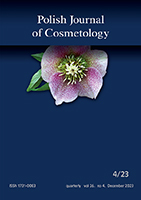search by
Copyright @ Pol J CosmetolBiotechnological production of hyaluronic acidPatrycja Maligłówka, Katarzyna Duda-Grychtoł, Sylwia Klasik-Ciszewska Silesian Medical College in Katowice Summary Hyaluronic acid (HA) is a substance present in almost all tissues of the human body. In terms of chemical structure, this acid is one of the glycosaminoglycans, which are polysaccharides. Hyaluronic acid disaccharide is composed of an acid D-glucuronic acid and N-acetylglucosamine joined by a glycosidic bond β-alternating (1-4) and β-(1-3). This compound was discovered in 1934 by Karl Meyer and John Palmer, who have isolated HA from bovine vitreous of the eye. It has been shown that hyaluronic acid has many important functions. One important is the ability to bind water. The moisturizing properties of this substance give the skin elasticity, resilience and affect the normal keratinization. It is worth noting that HA is a compound of identical structure in all living organisms. It is devoid of immunogenic properties, which makes it possible to obtain it from a variety of sources, and then used safely. Thanks to its properties and high biocompatibility, hyaluronic acid has been widely used in many fields. It is used in therapeutic medicine, aesthetic, cosmetic, pharmaceutical and tissue engineering. Currently, hyaluronic acid may be obtained by extracting it from animal tissues or by means of biotechnological processes, using for this purpose, among others, Streptococcus bacteria. The method is based on bacterial fermentation to be considered as the most secure and efficient. The biotechnological production of hyaluronic acid on a commercial scale is an important method and conditions for culturing the bacterial strains which clearly determines the receiving quality of hyaluronic acid. Key words: Hyaluronic acid, Streptococcus equi, Hyaluronic acid fermentation, Bacillus subtilis, Lactococcus lactis, Escherichia coli |




